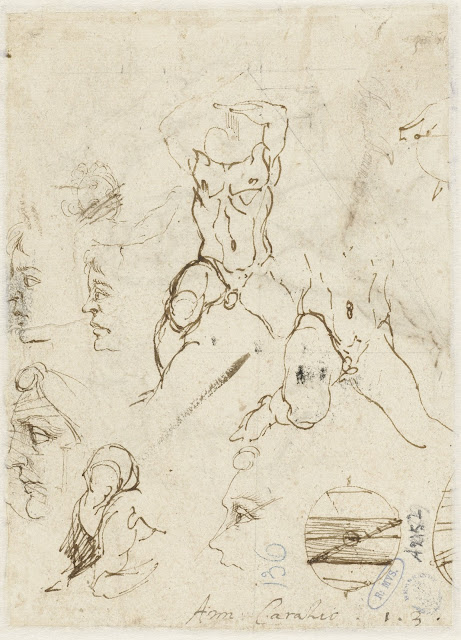 |
| Anonymous artist Académie with Horse ca. 1600-1700 drawing Rijksmuseum, Amsterdam |
 |
| attributed to Annibale Carracci Sheet of anatomical and other sketches before 1609 drawing Rijksmuseum, Amsterdam |
"Duclos one day told Mme. de Rochefort and Mme. de Mirepoix how prudish courtesans tended to become, how they would not listen to any story that was even a little bit daring. "They are far more prim," he said, "than virtuous women." And with that he launched into a very gay tale, then another that went somewhat further, and finally when his third story began even more lustily, Mme. de Rochefort stopped him and said, "Be careful, Duclos. We may not be as virtuous as you seem to think."
 |
| Giuseppe Cesari Figure Study before 1640 drawing Rijksmuseum, Amsterdam |
 |
| Giuseppe Cesari Study of Right Arm before 1640 drawing Rijksmuseum, Amsterdam |
 |
| Guglielmo Cortese Figure and Drapery Study of Woman in Motion ca. 1664-66 drawing Rijksmuseum, Amsterdam |
"Before Mademoiselle Clairon brought in costume at the Théâtre Française, all tragedies were performed in the same garment, called a Roman gown, which was worn whether the characters were Greeks, Americans, Spaniards, or something else. Lekain was the first to consent to wear a real costume; he had a Greek gown made to play Oreste in Andromaque. Dauberval came into Lekain's dressing-room just as the wardrobe manager of the Comédie was bringing in the gown for Oreste. The novelty of it made a great impression on Dauberval, and he asked what it was. "It's called a Greek gown," said Lekain. "Ah! It's beautiful!" Dauberval said. "The next time I need a Roman gown, I'll have them make me a Greek one."
 |
| Guglielmo Cortese Two Studies for Figure of God the Father ca. 1664-66 drawing Rijksmuseum, Amsterdam |
 |
| Willem Doudijns Académie 1680 drawing Rijksmuseum, Amsterdam |
 |
| Guercino Half-length Studies of Two Men before 1666 drawing Rijksmuseum, Amsterdam |
 |
| Guercino Half-length Study of a Woman before 1666 drawing Rijksmuseum, Amsterdam |
"La Gabrielli, a famous singer, asked five thousand ducats of the Empress, to sing for two months in St. Petersburg. The Empress said, "I pay none of my field marshals on that scale." "In that case," said La Gabrielli, "Your Majesty should of course have her field marshals sing." The Empress paid the five thousand ducats."
 |
| Eustache Le Sueur Reclining Figures ca. 1627-55 drawing Rijksmuseum, Amsterdam |
 |
| attributed to Daniel Mytens the Younger Académie before 1688 drawing Rijksmuseum, Amsterdam |
 |
| Caspar Netscher Académie before 1684 drawing Rijksmuseum, Amsterdam |
 |
| Cornelis van Poelenburgh Half-length Study - Legs ca. 1622-24 drawing Rijksmuseum, Amsterdam |
 |
| attributed to Peter Paul Rubens Half-length Study - Back before 1640 drawing Rijksmuseum, Amsterdam |
"At Anvers, in one of the main churches, I saw the tomb of Plantin, a famous printer, embellished with superb paintings by Rubens, dedicated to his memory. The sight made me think of the Éstienne brothers, Henri and Robert, whose Greek and Latin erudition has rendered immense service, and who eked out a miserable existence in France; and Charles Éstienne, their successor, who died in the paupers' hospital after having made contributions nearly as great to the progress of literature. I remembered how André Duchêne, who may be considered the father of French history, was forced by poverty to leave Paris and take refuge on a small farm he had in Champagne. He was killed in a fall from a loaded hay wagon that had been piled to a great height. Adrien de Valois, the pioneer of the history of metals, enjoyed no better fate. Samson, the father of geography, went out on foot, at the age of seventy, to give lessons, in order to keep alive. Everyone knows how Duryer fared, and Tristan and Maynard, and countless others. There was not enough broth for Corneille in his last illness. La Fontaine was no better off. If Racine, Boileau, Molière and Quinault were more fortunate, it is because their talents were consecrated more particularly to the king. The Abbé Delonguerue, who has brought together, and recounts a number of these anecdotes concerning the sad lot of illustrious men of letters in France, adds, "This is the way it has always been in this wretched country."
– passages are quoted from Products of the Perfected Civilization: selected writings of Chamfort, edited and translated by W.S. Merwin (New York: Macmillan, 1969)